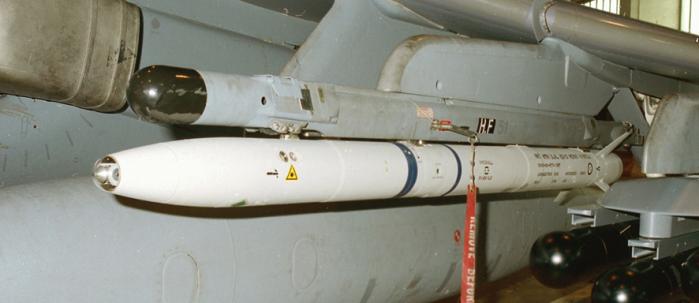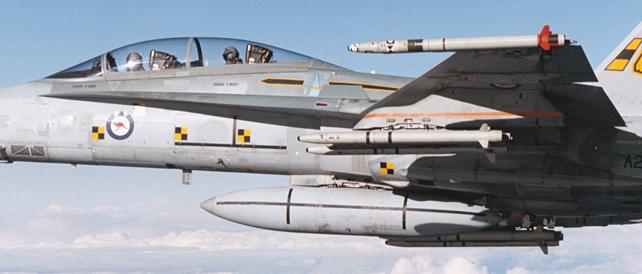MBDA (BAe Dynamics/Matra) AIM-132 ASRAAM
The ASRAAM (Advanced Short-Range Air-to-Air Missile) is a new European (mainly British) short-range air-to-air missile. It is included in this directory of U.S. missiles because it was at one time planned to replace the AIM-9 Sidewinder in U.S. service and therefore received the official DOD missile designation AIM-132.
In 1980, a joint U.S./European agreement for development of a new family of air-to-air weapons was signed. This agreement put the responsibility for the BVR (Beyond Visual Range) AMRAAM (Advanced Medium-Range Air-to-Air Missile) to the United States (leading to the AIM-120), while the complementary ASRAAM "dogfight missile" would be developed in Europe. After a joint British/German/Norwegian project definition phase between 1984 and 1987, it was decided to proceed with the development of the ASRAAM. The U.S. missile designation YAIM-132A was allocated to the forthcoming ASRAAM prototypes, although the U.S. military was not satisfied with the results of the definition phase. The AIM-132 was to be developed by a joint venture of the British company BAe Dynamics and the German BGT (Bodensee Gerätetechnik). In March 1989 the design was finalized but a few months later Germany pulled out of the program because of different requirements. While the UK put emphasis on high velocity and increased range, Germany insisted on a dogfight-optimized missile with extreme manoeuverability using TVC (Thrust-Vectoring Control) (this requirement eventually led to the IRIS-T missile development program). To make things worse, the other ASRAAM partners (USA, Canada, Norway) pulled out of the program in 1990, too.
In May 1991 the UK requested proposals from the industry for a new short-range air-to-air missile. Several companies submitted their designs, and in March 1992 a development contract for the ASRAAM was finally awarded to BAe Dynamics. Firing trials of the YAIM-132A began in 1994, and in February 1998 the ASRAAM gained its first international customer, when Australia selected the missile to arm its F/A-18 Hornet aircraft. In December 1998 the first ASRAAM missiles were delivered to the RAF for systems integration.
 |
| Photo: MBDA |
| AIM-132A |
The AIM-132 is a high-speed short-range rocket-powered missile with a low-drag configuration without any forward flying surfaces. The missile is compatible with all available target designation systems like radar, electro-optical sensors and helmet-mounted cueing sights, and its low-smoke solid-propellant rocket motor provides very high acceleration off the launch rail. Using its four cruciform tail surfaces, the ASRAAM can pull up to 50 g immediately after launch. The main improvement compared to the existing AIM-9L/M Sidewinder, however, is the new Focal Plane Array IIR (Imaging Infrared) seeker, which is similar to the one used in the American AIM-9X. This seeker has a long acquisition range, high countermeasures resistance, high off-boresight (+/- 90°) field-of-view, and the capability to designate specific parts of the targeted aircraft (like cockpit, engines, etc.). The ASRAAM also has a LOAL (Lock-On After Launch) capability which is a distinct advantage when the missile is carried in an internal weapons bay. The maximum effective range of the missile of course depends on the exact parameters (e.g. head-on or tail-chase engagement), but a figure of 15 km (8 nm) is sometimes quoted (the true figure is probably higher). Minimum range is quoted as around 300 m (1000 ft). The ASRAAM is armed with a 10 kg (22 lb) blast-fragmentation warhead, which is triggered by a combined laser proximity/impact fuzing system.
 |
| Photo: MBDA |
| AIM-132A |
To develop and produce the ASRAAM, BAe Dynamics had formed a joint venture with the French Matra company in 1996. In 2001, this and several other European missile manufacturers were incorporated into the new company MBDA Missile Systems. While the RAF had still rejected full-scale procurement of ASRAAM in 2001 because it was not meeting performance goals in some key areas, these problems have apparently been solved, and ASRAAM was finally declared ready for operational use with the RAF in September 2002. Although there are no plans by the U.S. military to procure this missile, the official DOD designation AIM-132A has been assigned to the production ASRAAM at the request of the Royal Australian Air Force.
Specifications
Note: Data given by several sources show slight variations. Figures given below may therefore be inaccurate! Especially the range figure is a rough estimate only.
Data for AIM-132A:
| Length | 2.90 m (9 ft 6 in) |
| Finspan | 45 cm (17.7 in) |
| Diameter | 16.6 cm (6.5 in) |
| Weight | 87 kg (192 lb) |
| Speed | Mach 3+ |
| Range | 15 km (8 nm) |
| Propulsion | Dual-thrust (boost/sustain) solid-fueled rocket |
| Warhead | 10 kg (22 lb) blast-fragmentation |
Main Sources
[1] Hajime Ozu: "Missile 2000 - Reference Guide to World Missile Systems", Shinkigensha, 2000
[2] Bernard Blake (ed.): "Jane's Weapon Systems 1987-88", Jane's, 1988
[3] MBDA Website
Back to Current Designations Of U.S. Unmanned Military Aerospace Vehicles
Back to Directory of U.S. Military Rockets and Missiles
Last Updated: 10 November 2002